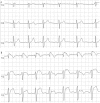Reduced Penetrance and Variable Expression of SCN5A Mutations and the Importance of Co-inherited Genetic Variants: Case Report and Review of the Literature
- PMID: 24948852
- PMCID: PMC4032780
- DOI: 10.1016/s0972-6292(16)30754-9
Reduced Penetrance and Variable Expression of SCN5A Mutations and the Importance of Co-inherited Genetic Variants: Case Report and Review of the Literature
Abstract
Mutations in the SCN5A gene are responsible for multiple phenotypical presentations including Brugada syndrome, long QT syndrome, progressive familial heart block, sick sinus syndrome, dilated cardiomyopathy, lone atrial fibrillation and multiple overlap syndromes. These different phenotypic expressions of a mutation in a single gene can be explained by variable expression and reduced penetrance. One of the possible explanations of these phenomena is the co-inheritance of genetic variants. We describe a family where the individuals exhibit a compound heterozygosity in the SCN5A gene including a mutation (R1632H) and a new variant (M858L). Individuals with both the mutation and new variant present with a more severe phenotype including spontaneous atrial tachyarrhythmia at young age. We give an overview of the different phenotypes of "SCN5A disease" and discuss the importance of co-inherited genetic variants in the expression of SCN5A disease.
Keywords: Brugada syndrome; SCN5A disease; genetic variants.
Figures



References
-
- Chen Q, et al. Genetic basis and molecular mechanism for idiopathic ventricular fibrillation. Nature. 1998;392:293. - PubMed
-
- Wang Q, et al. Cardiac sodium channel mutations in patients with long QT syndrome, an inherited cardiac arrhythmia. Hum Mol Genet. 1995;4:1603. - PubMed
-
- Schott JJ, et al. Cardiac conduction defects associate with mutations in SCN5A. Nat Genet. 1999;23:20. - PubMed
-
- McNair WP, et al. SCN5A mutation associated with dilated cardiomyopathy, conduction disorder, and arrhythmia. Circulation. 2004;110:2163. - PubMed
LinkOut - more resources
Full Text Sources
Miscellaneous
